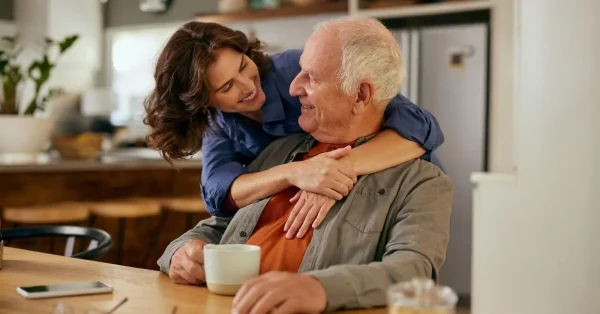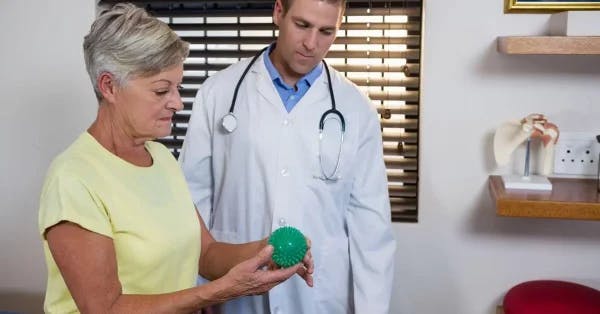Paralysis refers to the complete or partial loss of muscle function. A neurological injury such as stroke or spinal cord injury can cause different types of paralysis, including spastic paralysis (caused by increased muscle tone) and flaccid paralysis (caused by reduced muscle tone). Knowing how to distinguish between spastic vs flaccid paralysis is important to receive proper treatment and maximize the chances of recovery.
This article will differentiate spastic vs flaccid paralysis and discuss the best methods to promote movement in the affected muscles.
How Does the Nervous System Control Muscle Movement?
To understand the difference between spastic vs flaccid paralysis, it first helps to understand how the nervous system contributes to muscle movement.
The nervous system includes two main components: the central nervous system and the peripheral nervous system. The central nervous system includes the brain and spinal cord, which are the planning, coordinating, and organizing centers that control most of our daily activities.
The peripheral nervous system branches out from the spinal cord, connecting the central nervous system to the rest of the body. It carries signals from the brain or spinal cord to the muscles to tell them to contract or relax. It also transmits signals regarding sensations back to the brain for processing.
Motor neurons play a vital role in carrying signals regarding muscle movement, creating complex circuits throughout the body and transmitting signals regarding both voluntary and involuntary movement.
To cause a contraction in your muscles, signals are transmitted sequentially through the following pathway:
- Motor cortex of the brain (initiates motor signals)
- Upper motor neuron (transmits motor signals from the brain through the spinal cord)
- Lower motor neuron (connects with upper motor neuron in the spinal cord and transmits motor signals to the muscles
When certain parts of this neural pathway become damaged, spastic or flaccid paralysis may occur. Paralysis refers to the loss of motor function in one or multiple parts of the body.
For example, when upper motor neurons sustain damage, spasticity (muscle stiffness) or spastic paralysis may occur. On the other hand, damage to lower motor neurons may result in weakness, loss of muscle, twitching, or flaccid paralysis.
What Causes Paralysis?
Paralysis can develop due to many conditions that affect the nervous system. Studies have shown that stroke and spinal cord injury are the leading causes of paralysis, contributing to 33.7% and 27.3% of paralysis cases, respectively. Some other causes include multiple sclerosis, cerebral palsy, and traumatic brain injury.
Paralysis after a stroke occurs when areas of the brain responsible for motor control become damaged. Each hemisphere of the brain controls movement on the opposite side of the body. Therefore, when a stroke causes paralysis, it often leads to hemiplegia, or paralysis on either the right or left side of the body, opposite to the location of the brain damage.
Paralysis after a spinal cord injury occurs when the spinal cord is damaged, and nerves can no longer send signals from the brain to your muscles. This can cause paraplegia (paralysis in the lower limbs) or quadriplegia (paralysis in all four limbs).
Depending on the severity and location of the stroke or spinal cord injury, survivors may experience spastic or flaccid paralysis.
Differentiating Between Spastic vs Flaccid Paralysis
Though spastic paralysis and flaccid paralysis are both neurological disorders that interfere with voluntary muscle movement, they are two highly distinct types of paralysis.
One key difference is that in spastic paralysis, the muscles remain in constant contraction and become rigid and immobile. On the other hand, in flaccid paralysis, the muscles cannot contract and, as a result, become floppy and immobile. Although the underlying mechanism for abnormal contractions differs, in both flaccid and spastic paralysis, the muscles lose their proper function.
Spastic paralysis can occur when the upper motor neurons become damaged, resulting in a loss of voluntary control over the affected muscles. With spastic paralysis, the signals that tell the muscles to contract or relax are not controlled well by the cortex of the brain. This results in an overstimulation of the muscles. The muscles respond to this by contracting too much and becoming tight and hard. As a result, survivors may experience muscle stiffness, spasms, or uncontrollable twitching.
Flaccid paralysis can occur when motor neurons become damaged, not allowing nerve impulses to reach the intended muscles. There is no voluntary control of the muscles in flaccid paralysis, but there isn’t any involuntary control either, meaning the muscles don’t contract at all. Flaccid paralysis results in low muscle tone, the amount of tension or resistance to movement in a muscle. It also causes muscles to shrink and become loose or flabby.
Spastic paralysis and flaccid paralysis differ from each other and therefore require different treatment at times. This is why it is important to understand your type of paralysis with its prescribed proper treatment.
How Passive Exercises Can Help Improve Spastic and Flaccid Paralysis
Damage from a neurological injury can affect the neural pathways within the nervous system, resulting in spastic or flaccid paralysis. To strengthen the existing neural connections and create new ones, neuroplasticity must be activated.
Neuroplasticity is the nervous system’s ability to heal and rewire itself. Restoring connections means better communication between the nervous system and the muscles. This helps maximize the chances of restoring movement and improving paralysis.
Neuroplasticity is best activated through massed practice, or high repetition of exercises. The more a certain skill is performed, the more the nervous system will recognize its importance and restore neural pathways for that skill.
The best way to stimulate neuroplasticity if you have limited or no mobility is with passive exercise. While active exercises are performed using your own initiative, passive exercises involve assistance from your unaffected limbs or the help of a trained caregiver or therapist.
Even if you cannot move your muscles yourself, passive exercises help send signals to the nervous system to stimulate neuroplasticity, which is essential for spastic and flaccid paralysis rehabilitation.
Want 25 pages of stroke recovery exercises in a PDF? Click here to download our free Stroke Rehab Exercise ebook now (link opens a pop up for uninterrupted reading)
Treating Spastic vs Flaccid Paralysis
Treatment for spastic vs flaccid paralysis may vary depending on the severity. However, both types of paralysis should be treated in a timely manner in order to prevent further injury or complications.
If flaccid paralysis is left untreated, the muscles can begin to atrophy (reduce in size and waste away). This will lead to joint subluxation and pain. If spastic paralysis is left untreated, it can lead to frozen joints, shortened tendons and stiff muscles that can no longer be stretched.
More serious complications, such as contractures or pressure sores on the skin, can also develop if paralysis is neglected. To reduce the chances of spastic or flaccid paralysis worsening or developing serious complications, it’s crucial to have a suitable rehabilitation exercise plan.
This can include a combination of therapy exercises for spastic and flaccid paralysis such as:
- Passive Range of Motion Exercise: Most rehab exercises can be converted into passive exercises with the help of your unaffected limbs or a therapist. Passive exercise generally involves moving the affected joints through their full range of motion. This will counteract the natural tendency for a muscle to shorten its length when it is not stretched regularly in all directions. Passive range of motion exercises help prevent contractures and pressure sores, increase muscle flexibility, and reduce muscle stiffness and spasticity. Individuals with flaccid paralysis can also benefit from passive range of motion exercises to boost their chances of recovery. This is because the motion stimulates the nervous system and activates neuroplasticity.
- Physical Therapy: A Physical Therapist can help you by assigning targeted exercises that will reduce spasticity and train you and your family to execute exercises that stimulate recovery. Movement is crucial to stimulate the nervous system, prevent muscle atrophy, and lower the risk of other complications from paralysis.
- Occupational Therapy: An Occupational Therapist can teach you restorative and compensatory strategies to perform daily activities and maximize independence. Performing meaningful tasks at home motivates you to continue moving more and this stimulates recovery. In addition, OTs are experts in finding Adaptive equipment that can make life easier at home and give you a little more independence.
- Home Therapy Exercises: Time with therapists is limited, but your brain/body can be learning all the time. So, performing stretches or exercises at home is essential to recovery. Your body needs you to repeat motions many times to adapt and change. Muscles lengthen and neuroplasticity is stimulated when you do therapeutic activities at home. It is not always easy to be motivated to do these things at home, but new technology has made that a lot more fun, and many are discovering its effects. Home therapy includes the use of neurorehabilitation devices such as FitMi and MusicGlove, which can be used passively to help improve flaccid and spastic paralysis.
Along with paralysis recovery exercises, some individuals may benefit from other types of treatment. Depending on the severity of paralysis, this can include:
- Medication: Secondary complications of paralysis such as pain and depression can interfere with the motivation needed to pursue rehabilitation. To help reduce pain and/or depression, doctors may prescribe pain relievers or antidepressants. They may also prescribe muscle relaxants for spastic paralysis due to the increase in muscle tone.
- Splints or Orthotic Devices: Individuals experiencing paralysis often benefit from the use of splints or orthotic devices to promote proper muscle alignment, stabilize the joints, and/or gently stretch spastic muscles. Consult with your doctor or therapist about which type of orthotic could be right for you.
- Botox: Botulinum toxin, or Botox, is a neurotoxin used to treat spasticity and relax stiff muscles, and therefore may be helpful with spastic paralysis but not with flaccid paralysis. It works by killing the nerve cells that are overactive and therefore causing too many contractions in a spastic muscle.
- Surgery: Studies have shown that advanced nerve surgery techniques alongside physical therapy may help treat paralysis after a spinal cord injury, particularly in the hands and arms. Surgery is highly invasive and should only be considered when all other treatments have been exhausted.
- Electrical Stimulation: This is a promising treatment for flaccid and spastic paralysis. During electrical stimulation, electrodes are placed on the surface of the skin over the affected muscles. Then, a therapist will apply electrical stimulation while controlling the strength and frequency of the impulse. Electrical impulses help the muscles contract and promote movement. Studies have shown that electrical stimulation combined with rehab exercise is even more effective than rehab exercise alone.
- Electroacupuncture: This is a combination of acupuncture and electrical stimulation. It works by inserting thin needles into specific points on your body and then electrical stimulation is gently applied to the needles. The more stimulation your body receives, the more it can help activate the nervous system and promote movement in your flaccid muscles.
Orthotic devices, electrical stimulation and electroacupuncture are most effective when combined with therapy exercises. Speak to your therapist to learn what treatment combination is safe and suitable for your condition.
Understanding Spastic vs Flaccid Paralysis
Stroke and spinal cord injury are the two leading causes of paralysis. Differentiating between spastic vs flaccid paralysis is important to obtain a proper rehabilitation plan. Your combination of treatments may vary depending on the type and severity of your paralysis. However, all individuals can benefit from passive exercises that help stimulate the nervous system and activate neuroplasticity.
We hope this article has helped you understand how spastic vs flaccid paralysis can develop and encouraged you to find a suitable home therapy exercise regimen.










